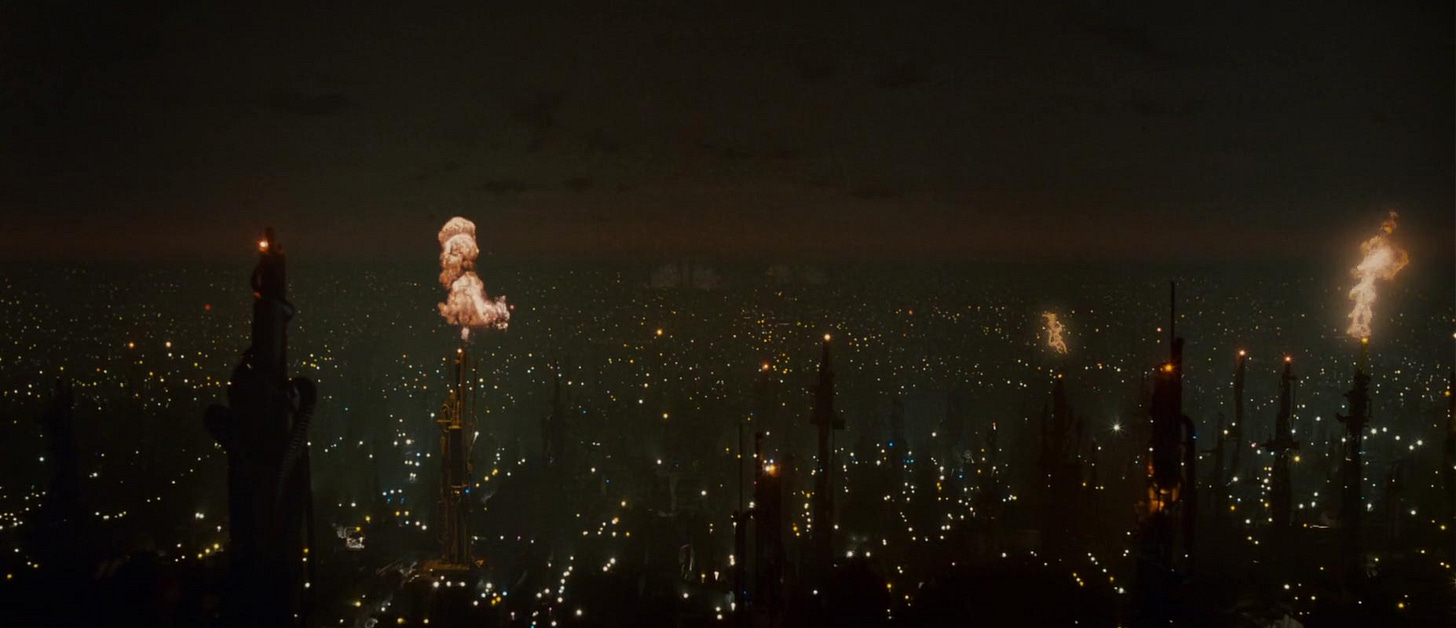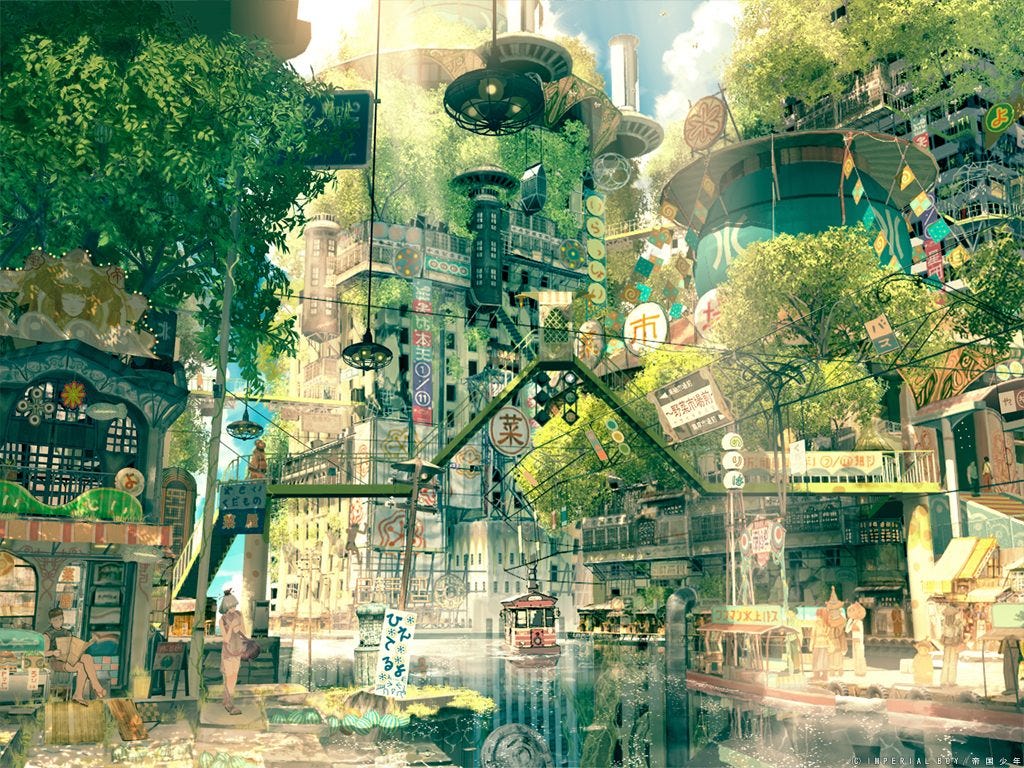“Oh, the vision thing.” — George H. W. Bush
If you’re anything like me, you signed up for a film class during your final undergraduate semester. You blithely expected it to be a fun, easy A — watching movies for a grade! — before the villain arrived: an over-zealous graduate student screamed at you and the rest of the class after a pop-quiz for not caring enough about “the cinema.” And so you promptly switched to taking the class pass-fail.
I can’t blame him (oh, come on, it was obviously a him) too much though, as that class was my first experience with some wonderful films, particularly Chungking Express and Blade Runner.
The atmospherics of Blade Runner dominate its plot. A cop, maybe a robot himself, chases some robots before they can do too much damage in dystopia LA, I guess. If the sets and score are what you remember from a movie, and not its story, well, that’s a choice. But those atmospherics were incredible—bold yet grounded. They felt real. One could imagine living there.
Blade Runner depicted Los Angeles in 2019 as immensely dense and diverse, cloudy and with a good noodle shop on every corner. Noah Smith had a nice post about imagining urban futures as a necessary step to attain them.
I completely agree with Noah’s post on this, and strongly recommend following @alfred_twu on Twitter for such depictions.



And while I do have thoughts on urban design that I’ll share down the line, I want to apply the concept of the benefits from imaginative futures to a different domain: American foreign policy. The usually implicit animating force behind significant amounts of foreign policy in the United States is endless American hegemony. And … I get it. Hegemony is nice (for the hegemon). Affirmatively stating goals about desired end states, about short-term fixes, about processes to get to the former via the latter should be a bigger part of the debate than it currently is.
Here’s just a smattering of thoughts/ideas/actions along these lines (which kind of feels like a Christmas list, thus the timing).
A world less beset by poverty, the diseases and deprivations associated with it.
A world transitioning to clean technologies to avoid the ravages of climate change, while acknowledging that energy poverty also cuts off billions from opportunities and safety.
A world successfully fighting off humanity’s archaic nemeses — bacterial and viral infections — not just for those lucky enough to be born in rich countries, but globally, since the COVID-19 pandemic has made obvious how interconnected humanity has become.
A world where people can survive and thrive.
Now, obviously perhaps few would object to these goals. And surely it is reasonable for those running American foreign policy to prioritize the interests of their own citizens to some extent even if they are generally cosmopolitan in their outlook. Hard questions, though, are everywhere both abstract ones—what do citizens owe their governments, what accountability do officials face for their decisions, how does free speech interact with a polarized demos living in echo chambers—as well as more concrete policy questions—what is a reasonable set of actions to take to reduce the chances of conflict over Ukraine or Taiwan while balancing the varied interests of the people in those places and reputational effects (if any) of those actions on other relationships (see the double-edged AUKUS, perhaps increasing military effectiveness but undermining the US-France partnership). Tradeoffs over time can be even harder — do you pursue a first-best option now even if it entails worse options down the line?
Stating these desired ends can be helpful to clarify what matters. Different people will understandably have different values and priorities. Transparency is often necessary for productive deliberation.1 But once one comes to a decision on what matters, then there are a set of actions to try to accomplish those ends based on beliefs about causal relationships in the world. For instance, if what you care about is improving the lives of the American people (which is a different goal than the lives of American workers), one could get fixated on the unemployment rate under the quite reasonable belief that people benefit when they are employed and when overall unemployment is low. But too much focus on a single indicator — unemployment (and even here, which of the six (!) unemployment rates that the Bureau of Labor Statistics calculates every month should be the focus) — would ignore possible problems that might arise that unemployment itself would not pick up (e.g. inflation). It can be hard to impossible to prove causation (as anyone who has run the gauntlet of peer review in the social sciences in the past decade). Even something like fighting climate change by reducing CO2 emissions can seem automatic, but it’s important to remember that CO2 isn’t the only greenhouse gas (methane! fluorocarbons!) and that our most common measures of CO2 tend to capture some but not all of those emissions as well (e.g. measuring fuel combustion but not emissions from deforestation (sometimes) or land use change (often)).
It’s Christmastime in COVID times, so I’ll end this reminder of the basics here. It’s already been a dozen years since Bill McKibben published Eaarth, which argued that all of our burning had created a different planet than the one that fostered humanity’s rise. Back then, average CO2 concentration was 390 ppm, we’re now at 415.
Blade Runner, like all good intellectual property, recently had a sequel, Blade Runner 2049.2 It, like its predecessor, attempted to depict a future world — this time mostly dry, orange, and hazy — a lot like another world imagined by Denis Villeneuve you might have seen recently.
But while the sequel tried to look three decades into the future, reality has come crashing through. Here’s San Francisco’s iconic connection to Marin county at midday in September.
We have to envision a different world because the old world is already dying, faster than we had imagined.
Of course, ambiguity also has its uses. E.g.
Somehow this “recent” movie came out in 2017? The deceptiveness of time in the Great Before is limitless.













